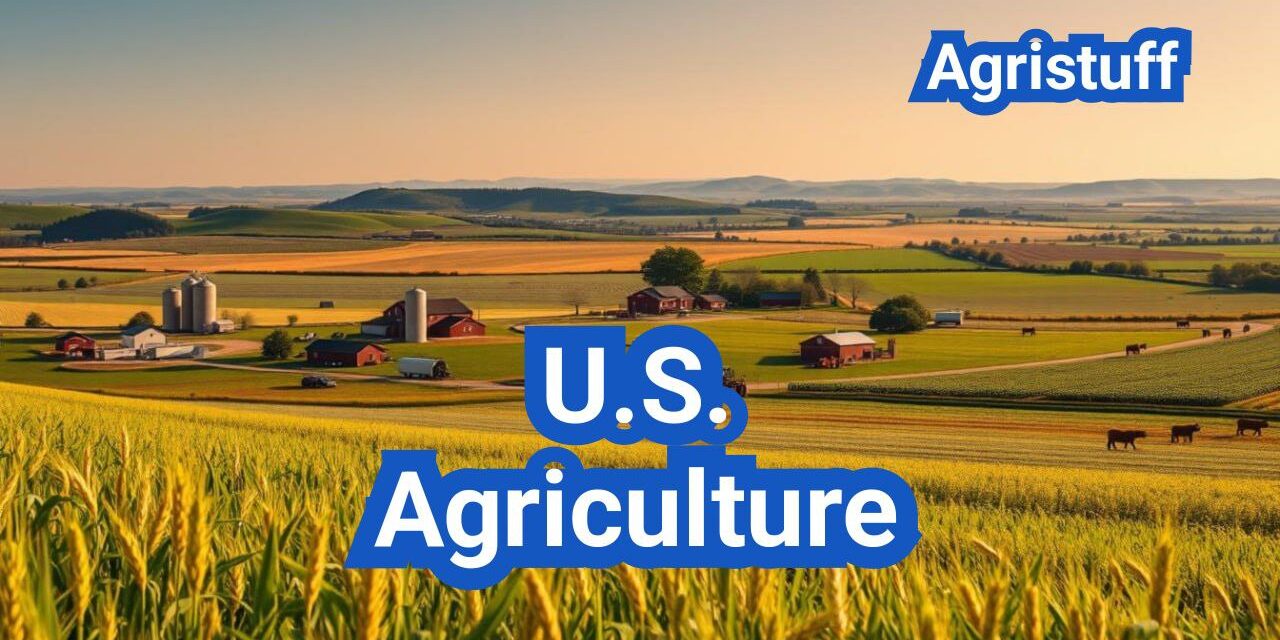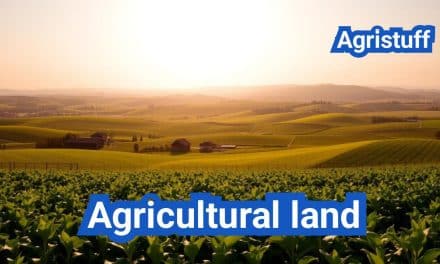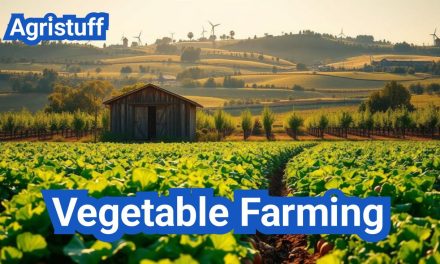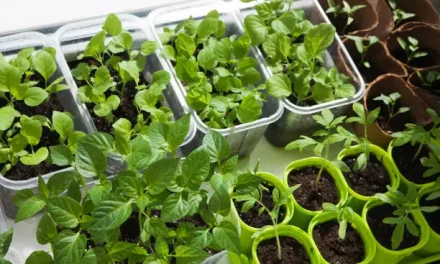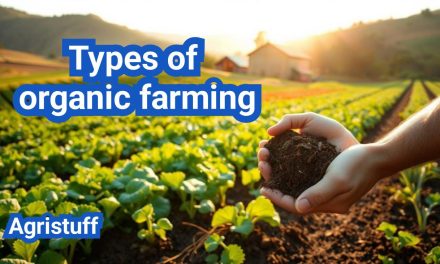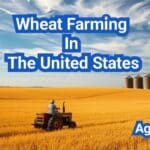The U.S. agriculture industry is a significant contributor to the country’s economy, encompassing various sectors, jobs, and outputs. According to the Bureau of Economic Analysis, in 2023, agriculture, food, and related industries contributed $1.537 trillion to the U.S. gross domestic product (GDP), accounting for a 5.5-percent share.
The output of America’s farms contributed $222.3 billion to this sum, representing about 0.8 percent of U.S. GDP. This article provides an overview of the diverse sectors within U.S. agriculture, the jobs they support, and the overall output.
Key Takeaways
- The U.S. agriculture industry contributed significantly to the country’s GDP in 2023.
- Agriculture, food, and related industries accounted for a 5.5-percent share of U.S. GDP.
- The output of America’s farms was $222.3 billion, or 0.8 percent of U.S. GDP.
- U.S. agriculture encompasses various sectors and supports numerous jobs.
- The industry’s overall output is a crucial component of the country’s economy.
The Current State of US Agriculture
The U.S. agricultural sector is a vital component of the country’s economy. It encompasses a wide range of activities, from crop production to livestock farming, and plays a significant role in the nation’s food security and international trade.
Key Statistics and Facts
The US agricultural industry is characterized by its significant output and diverse range of products. Some key statistics include:
- The total value of US agricultural products is over $300 billion annually.
- The industry employs approximately 22 million people, both directly and indirectly.
- US agriculture is a major player in global markets, with US agriculture exports reaching $176 billion in 2024.
Economic Significance
Agriculture is a significant contributor to the US economy, accounting for about 1% of the country’s GDP. However, its impact extends beyond this percentage due to its role in supporting related industries such as food processing and agricultural equipment manufacturing.
Global Position of American Agriculture
The United States is the world’s second-largest agricultural trader, behind the European Union. The global position of American agriculture is strengthened by its competitive advantages in terms of technology, infrastructure, and innovation.
| Category | Value (Billions) | Percentage of Total Exports |
|---|---|---|
| Crop Products | $120 | 68% |
| Livestock Products | $56 | 32% |
| Total US Agriculture Exports | $176 | 100% |
The data highlights the importance of US agriculture exports in the global market, with crop products being the dominant category.
How to Understand the Structure of US Agriculture

Understanding the structure of US agriculture requires a closer look at the different types of farms and their regional distribution. The agricultural landscape in the United States is vast and varied, with farms differing significantly in size, production focus, and economic output.
Farm Types and Classifications
US farms are classified based on their primary production activities, such as crop production, livestock farming, or a combination of both. As of the 2017 census of agriculture, there were 2.04 million farms in the US, covering an area of 900 million acres, with an average of 441 acres per farm. These farms can be further categorized into:
- Family-owned farms: The majority of US farms are family-owned, contributing significantly to the nation’s agricultural output.
- Specialty farms: Farms focusing on specific products like fruits, vegetables, or nursery crops.
- Livestock farms: Farms primarily engaged in raising animals for meat, dairy, or other products.
The diversity in farm types reflects the complexity and richness of US agriculture, enabling the country to be a major player in global food production.
Regional Distribution
The regional distribution of farms across the US is influenced by factors like climate, soil quality, and market demand. Different regions specialize in various agricultural activities:
- The Great Plains are known for their extensive grain production.
- California leads in the production of fruits, nuts, and vegetables.
- The Midwest is often referred to as the “breadbasket” of the US, with significant corn and soybean production.
Understanding these regional specializations is crucial for grasping the overall structure of US agriculture and its contribution to the national economy, including its impact on the US agriculture GDP.
The regional distribution and diversity of farm types underscore the complexity and resilience of US agriculture, making it a vital sector that supports both domestic consumption and international trade.
Navigating the Major Sectors in US Agriculture
The agricultural landscape in the US is characterized by a wide range of products, making it one of the most diverse and productive sectors in the country. The major sectors within US agriculture can be broadly categorized into crop production and livestock.
Crop Production
Crop production is a significant component of US agriculture, with the country producing a variety of crops that are used for both domestic consumption and export. Corn is one of the leading crops, with production reaching 392,000 thousand tons in 2018. Other major crops include soybeans and wheat, which are also crucial for the agricultural economy.
The US is a major player in global crop production, with its advanced farming techniques and technology contributing to high yields. The country’s crop production sector is also supported by favorable climate conditions in various regions, allowing for a diverse range of crops to be grown.
Livestock and Dairy
In addition to crop production, livestock and dairy are also vital sectors within US agriculture. The country is a leading producer of beef and dairy products, with a significant number of cattle farms across various states. The dairy sector is also prominent, with the US producing a substantial quantity of milk and other dairy products.
The livestock sector is supported by advanced breeding techniques and animal health programs, ensuring high-quality products. The integration of technology in livestock farming has also improved efficiency and productivity.
Overall, the major sectors in US agriculture, including crop production and livestock, contribute significantly to the country’s economy and food security. Understanding these sectors is crucial for navigating the complexities of US agriculture.
How to Use USDA Agricultural Zones for Growing Success

The USDA Plant Hardiness Zone Map is a vital tool for determining which plants can thrive in specific areas.
The USDA Plant Hardiness Zone Map divides the country into zones based on the average annual extreme minimum temperature, helping farmers decide which crops to plant.
Understanding Plant Hardiness Zones
Plant Hardiness Zones are defined by the average annual extreme minimum temperature. This information is critical for farmers to determine which plants can survive and thrive in their area.
For instance, a farmer in Zone 5 should choose crops that can withstand the zone’s minimum temperature. Understanding these zones helps in selecting the right crops, thus improving the chances of a successful harvest.
Regional Specialization Opportunities
Different regions specialize in various crops based on their hardiness zones and climate conditions. For example, warmer zones like Zone 10 are ideal for growing tropical crops such as avocados and mangoes.
Regional specialization allows farmers to focus on crops that are well-suited to their local climate, improving productivity and reducing the need for extensive climate control measures.
| Zone | Temperature Range (°F) | Suitable Crops |
|---|---|---|
| 3 | -40 to -30 | Potatoes, Rye |
| 5 | -20 to -10 | Apples, Carrots |
| 8 | 10 to 20 | Citrus, Avocados |
Climate Adaptation Strategies
Farmers can adapt to climate conditions by choosing crops that are resilient to the projected climate changes in their area. This might involve shifting to more drought-resistant crops in areas expected to become drier.
Understanding and utilizing the USDA’s climate data and plant hardiness zones can significantly enhance a farmer’s ability to adapt to changing climate conditions, ensuring continued success.
Analyzing the Economic Output of US Agriculture
Understanding the economic output of U.S. agriculture requires examining its various components, including its contribution to the gross domestic product (GDP), cash receipts by commodity, value-added products, and the broader economic multiplier effects.
Contribution to GDP
The agricultural sector, including food and related industries, contributed 5.5 percent to U.S. GDP in 2023. This significant contribution highlights the importance of agriculture to the national economy.
Cash Receipts by Commodity
Cash receipts from major commodities such as corn and soybeans are substantial contributors to farm income. In 2023, these commodities generated significant revenue, supporting farmers and rural economies.
Value-Added Agricultural Products
Value-added products, which result from processing raw agricultural commodities into higher-value goods, play a crucial role in enhancing farm income and contributing to the overall economic output of the agricultural sector.
Economic Multiplier Effects
Agricultural activities have significant economic multiplier effects, stimulating economic growth in related industries such as food processing, transportation, and retail. This ripple effect underscores the far-reaching impact of agriculture on the broader economy.
| Economic Indicator | Value (2023) |
|---|---|
| Contribution to GDP | 5.5% |
| Cash Receipts from Corn | $X billion |
| Cash Receipts from Soybeans | $Y billion |
How to Find and Succeed in US Agriculture Jobs
With its vast lands and advanced farming techniques, the US agriculture industry provides numerous job prospects. The sector employed approximately 2.6 million people directly on farms in 2022, showcasing its significant role as an employer.
Types of Agricultural Employment Opportunities
Agricultural employment opportunities are diverse, ranging from farm labor and management to specialized fields like agricultural science and technology. Jobs are available in crop production, livestock management, and dairy farming, among others. The industry also supports roles in research and development, particularly in precision agriculture techniques and biotechnology.
Required Skills and Education
The skills required in US agriculture jobs vary widely. While some positions demand manual labor, others require specialized knowledge in areas such as agricultural technology, farm management, and animal science. Educational requirements range from high school diplomas for farm labor positions to advanced degrees for roles in research and development. Continuous education and training are crucial for career advancement in this field.
Wage Statistics and Career Advancement
Wage statistics in US agriculture vary significantly by job type. Median wages range from around $11 to over $20 per hour, depending on the role and level of expertise. Career advancement opportunities exist, particularly for those with specialized skills or higher education. Advancements in agricultural technology also open new avenues for career growth.
Addressing Labor Challenges
The US agriculture industry faces labor challenges, including workforce shortages and the need for skilled labor. Addressing these challenges requires innovative solutions, such as leveraging technology to enhance productivity and attract a new generation of agricultural workers. Initiatives that promote sustainable farming practices and provide training in emerging agricultural technologies can also help mitigate these challenges.
A Guide to US Agriculture Department Programs and Services
The United States Department of Agriculture (USDA) plays a crucial role in the country’s agricultural sector, offering various programs and services to support farmers and ranchers. As the primary federal agency responsible for agriculture, the USDA’s mission is to promote agricultural productivity, sustainability, and rural development.
USDA Structure and Functions
The USDA is composed of several agencies, each focusing on different aspects of agriculture. These include the Farm Service Agency (FSA), which provides financial assistance to farmers; the Natural Resources Conservation Service (NRCS), which works on conservation efforts; and the Agricultural Research Service (ARS), which conducts research to improve agricultural practices.
How to Access Key Programs and Services
Farmers and ranchers can access USDA programs and services through various channels. For instance, the FSA offers loan programs for beginning farmers and ranchers, while the NRCS provides conservation programs to help agricultural producers manage natural resources effectively.
Research and Development Initiatives
The USDA invests in research and development initiatives to improve agricultural productivity and sustainability. The ARS conducts research in areas such as crop improvement, animal health, and environmental conservation.
Extension Services and Education
The USDA’s National Institute of Food and Agriculture (NIFA) supports extension services and education through programs like the Cooperative Extension System. These programs provide critical information and training to farmers, ranchers, and communities across the country.
By understanding the USDA’s structure and functions, farmers and ranchers can better navigate the various programs and services available to support their operations. Whether it’s through financial assistance, research initiatives, or educational programs, the USDA plays a vital role in promoting a thriving agricultural sector.
How to Understand Agricultural Trade and Exports

Understanding the dynamics of U.S. agricultural exports is essential for grasping the sector’s overall performance and its impact on the national economy. The U.S. agricultural sector is a significant player in the global economy, with exports playing a crucial role in its success.
Major Export Markets and Products
The U.S. agricultural exports reached $176 billion in 2024, with major export markets including Canada, Mexico, and China. These countries rely heavily on U.S. agricultural products, such as soybeans, corn, and wheat, to meet their domestic demand. The diversity of U.S. agricultural products allows the country to maintain a strong presence in the global market.
Trade Balance and Policies
The U.S. agricultural trade balance is influenced by various factors, including global demand, trade policies, and competition from other major exporters. The U.S. government implements policies to support farmers and promote exports, such as the U.S. Farm Bill and trade agreements like USMCA. These policies help maintain a favorable trade balance and ensure the competitiveness of U.S. agricultural products.
International Competition
The U.S. faces competition from other major agricultural exporters like Brazil and the European Union. These competitors offer a range of agricultural products, often at competitive prices, which can impact U.S. market share. To remain competitive, U.S. farmers and exporters must adapt to changing global market conditions and leverage export assistance programs.
Export Assistance Programs
The U.S. government offers various export assistance programs to support farmers and exporters. These programs provide resources and services to help U.S. agricultural products access new markets and comply with international regulations. By utilizing these programs, U.S. farmers can expand their customer base and increase their exports.
Accessing Farm Subsidies and Support Programs

Understanding the various farm subsidy programs available is essential for farmers looking to access financial support. The U.S. Department of Agriculture (USDA) offers a range of subsidy programs designed to help farmers manage risks, improve their operations, and maintain a stable income.
Types of Agricultural Subsidies
The USDA provides several types of subsidies, including direct payments, crop insurance, and disaster assistance. Direct payments are made to farmers based on their historical production of certain crops, while crop insurance helps protect against crop failure or revenue loss. Disaster assistance programs provide support in the event of natural disasters.
- Direct Payments: Financial support based on historical crop production.
- Crop Insurance: Protection against crop failure or revenue loss.
- Disaster Assistance: Support during natural disasters.
Eligibility Requirements
Eligibility for farm subsidies varies by program. Generally, farmers must meet certain requirements related to their farming operation, such as being actively engaged in farming and having a certain level of income or production. The USDA sets these requirements to ensure that subsidies are targeted effectively.
Application Process and Timeline
The application process for farm subsidies typically involves submitting an application through the USDA’s Farm Service Agency (FSA) or other designated agencies. The timeline for applications can vary, but it is essential to apply within the specified deadlines to be considered for support.
Impact on Farm Economics
Farm subsidies can have a significant impact on farm economics by providing financial stability and helping farmers manage risks. By reducing the financial burden of farming operations, subsidies can enable farmers to invest in their businesses, improve productivity, and contribute to the overall health of the agricultural sector.
By understanding the different types of subsidies available, meeting eligibility requirements, and following the application process, farmers can access the support they need to succeed. The USDA’s subsidy programs play a critical role in maintaining the viability of U.S. agriculture.
Understanding Land Values and Ownership Patterns

Understanding the dynamics of land values and ownership patterns is crucial for the future of US agriculture. The agricultural landscape is shaped by various factors, including economic conditions, government policies, and environmental considerations.
Trends in Agricultural Land Prices
Agricultural land prices have seen significant fluctuations over the years. Factors such as commodity prices, government subsidies, and urbanization have influenced these trends. For instance, the average value of agricultural land in the US has been steadily increasing, with some regions experiencing more rapid growth than others.
Ownership Models and Transitions
Land ownership patterns in the US are diverse, ranging from individual farmers to large corporate entities. The transition of land from one generation to the next or between different owners can be complex, involving various legal and financial considerations.
Access Strategies for New Farmers
New farmers face challenges in accessing agricultural land, including high land prices and competition from established farmers. Strategies such as leasing land, forming partnerships, or utilizing government programs can help new entrants into the agricultural sector.
Land Conservation Programs
Land conservation programs play a vital role in protecting agricultural land for future generations. These programs provide financial incentives to farmers to adopt conservation practices, preserving the long-term productivity of the land.
| Program | Description | Benefits |
|---|---|---|
| Conservation Reserve Program (CRP) | Pays farmers to remove land from agricultural production | Improves soil health, reduces erosion |
| Environmental Quality Incentives Program (EQIP) | Provides financial assistance for conservation practices | Enhances water quality, reduces pollution |
| Wetlands Reserve Program (WRP) | Protects and restores wetlands | Preserves biodiversity, improves water quality |
By understanding land values, ownership patterns, and conservation programs, stakeholders in US agriculture can make informed decisions that support the long-term sustainability of the sector.
Implementing Technology and Innovation in US Agriculture

The integration of technology in U.S. agriculture is revolutionizing farming practices, making them more precise, productive, and environmentally friendly. This transformation is driven by several key technological advancements.
Precision Agriculture Techniques | U.S. agriculture
Precision agriculture involves the use of advanced technologies such as GPS-guided equipment and drones to optimize crop yields and reduce waste. These techniques enable farmers to monitor and manage their fields more effectively, applying the right amount of water, fertilizer, and pesticides exactly where needed.
Key benefits of precision agriculture include:
- Increased crop yields
- Reduced input costs
- Environmental sustainability
Biotechnology and Genetic Modification
Biotechnology and genetic modification are playing a significant role in U.S. agriculture, enabling the development of crops that are more resilient to pests, diseases, and environmental stresses. Genetically modified crops have become a staple in American agriculture, contributing to improved productivity and reduced pesticide use.
Automation and Robotics | U.S. agriculture
The adoption of automation and robotics in agriculture is enhancing efficiency and reducing labor costs. Automated farming equipment, such as robotic tractors and harvesters, can operate around the clock, improving productivity and reducing the physical strain on farm workers.
Data-Driven Decision Making | U.S. agriculture
Data-driven decision-making is becoming increasingly important in U.S. agriculture. Farmers are leveraging data from various sources, including satellite imagery, soil sensors, and weather stations, to make informed decisions about planting, irrigation, and harvesting. This data-driven approach helps optimize farm operations, improve yields, and reduce environmental impact.
By embracing these technological innovations, U.S. agriculture is poised to continue its legacy as a leader in productivity and sustainability, meeting the food needs of a growing global population.
Addressing Environmental and Sustainability Challenges

The U.S. agriculture sector is increasingly facing environmental challenges that require immediate attention and sustainable solutions. As the industry continues to grow, it must adapt to the impacts of climate change, improve water management, adopt sustainable farming practices, and participate in conservation programs.
Climate Change Adaptation Strategies
Climate change poses a significant threat to U.S. agriculture, with rising temperatures and altered precipitation patterns affecting crop yields and farm productivity. Adaptation strategies include the use of climate-resilient crop and animal varieties, improved irrigation systems, and soil conservation techniques. By adopting these strategies, farmers can reduce the vulnerability of their operations to climate change.
Water Management Techniques | U.S. agriculture
Effective water management is crucial for sustainable agriculture. Techniques such as drip irrigation and precision agriculture help reduce water waste and optimize water use. Additionally, practices like mulching and cover cropping improve soil health, enhancing its water-holding capacity.
Sustainable Farming Practices | U.S. agriculture
Sustainable farming practices are essential for reducing the environmental footprint of U.S. agriculture. These practices include crop rotation, organic farming, and integrated pest management. By adopting sustainable practices, farmers can improve soil health, biodiversity, and ecosystem services while reducing the use of chemical inputs.
Conservation Programs and Incentives
The U.S. government offers various conservation programs and incentives to encourage farmers to adopt environmentally friendly practices. Programs such as the Conservation Reserve Program (CRP) and the Environmental Quality Incentives Program (EQIP) provide financial assistance to farmers who implement conservation practices. These programs help protect natural resources, improve water quality, and enhance biodiversity.
Future Outlook: US Agriculture in 2025 and Beyond

The U.S. agricultural sector is poised for significant growth in the coming years, driven by technological advancements and increasing global demand. As the industry looks towards 2025 and beyond, several key trends and projections are expected to shape its future.
Growth Projections and Opportunities
Projections indicate continued growth in U.S. agricultural output, driven by advancements in precision agriculture, biotechnology, and data-driven decision-making. The sector is expected to see increased productivity and efficiency, leading to higher output and potentially lower costs.
Emerging Trends and Technologies | U.S. agriculture
Emerging trends in U.S. agriculture include the adoption of precision agriculture techniques, biotechnology, and automation. These technologies are set to revolutionize farming practices, enabling farmers to produce more with less. Additionally, the use of drones, satellite imaging, and IoT devices will become more prevalent, enhancing farm management and productivity.
Policy Directions and Implications | U.S. agriculture
Agricultural policy directions will play a crucial role in shaping the future of U.S. agriculture. Policies supporting sustainable farming practices, climate change adaptation, and trade agreements will be critical. These policies will influence the industry’s growth trajectory and its ability to adapt to emerging challenges.
Preparing for Future U.S. Agricultural Challenges
To prepare for future challenges, the agricultural sector must focus on innovation, sustainability, and resilience. This includes investing in research and development, adopting climate-resilient practices, and enhancing the sector’s ability to adapt to changing market conditions and consumer preferences.
By understanding these projections, trends, and policy directions, stakeholders in the U.S. agricultural sector can better prepare for the challenges and opportunities that lie ahead.
At The End of: Agriculture In USA
The U.S. agricultural sector is a complex and multifaceted industry that plays a crucial role in the national economy. As discussed throughout this article, U.S. agriculture encompasses various sectors, including crop production, livestock, and dairy, which contribute significantly to the country’s GDP.
The significance of U.S. agriculture jobs cannot be overstated, as they provide employment opportunities for millions of Americans. Moreover, the sector’s output is substantial, with the USDA reporting significant cash receipts from the sale of agricultural commodities.
In conclusion, the U.S. agricultural industry is a vital component of the national economy, with its diverse sectors, jobs, and output contributing to the country’s economic well-being. As the industry continues to evolve, it is essential to address the challenges it faces, such as climate change, trade policies, and technological advancements, to ensure its continued growth and success.
By understanding the intricacies of U.S. agriculture and its various components, stakeholders can better navigate the complexities of this critical industry and work towards a more sustainable and productive future.
FAQ
What is the significance of U.S. agriculture?
U.S. agriculture is a vital sector of the American economy, providing food, feed, and fiber, as well as contributing to the country’s GDP and employing millions of people.
What are the major sectors within U.S. agriculture?
The major sectors within U.S. agriculture include crop production, livestock, and dairy, with significant contributions from other areas such as forestry and fisheries.
How do USDA agricultural zones impact farming?
USDA agricultural zones, also known as plant hardiness zones, help farmers determine which crops can be grown in their area and inform decisions on planting, breeding, and harvesting.
What is the economic output of U.S. agriculture?
The economic output of U.S. agriculture is substantial, contributing to the country’s GDP, generating cash receipts, and producing value-added products.
What types of jobs are available in U.S. agriculture?
U.S. agriculture offers a range of employment opportunities, including farming, ranching, agricultural management, research, and education, among others.
How can farmers access USDA programs and services?
Farmers can access USDA programs and services through various channels, including local USDA offices, online portals, and by contacting USDA representatives directly.
What is the role of subsidies in U.S. agriculture?
Subsidies play a crucial role in supporting U.S. farmers, helping to mitigate risks, and ensuring the stability of the agricultural sector.
How is technology transforming U.S. agriculture?
Technology is revolutionizing U.S. agriculture, with advancements in precision agriculture, biotechnology, automation, and data-driven decision-making, among others.
What are the environmental and sustainability challenges facing U.S. agriculture?
U.S. agriculture faces various environmental and sustainability challenges, including climate change, water management, and the adoption of sustainable practices.
What is the future outlook for U.S. agriculture?
The future outlook for U.S. agriculture is promising, with growth projections, emerging trends, and technologies expected to shape the sector in the years to come.
How do agricultural trade policies impact U.S. farmers?
Agricultural trade policies can significantly impact U.S. farmers, influencing their ability to export products, compete in global markets, and navigate international trade agreements.
What are the different types of farm subsidies available?
There are various types of farm subsidies available, including direct payments, crop insurance, and disaster assistance programs, among others.
How can new farmers access agricultural land?
New farmers can access agricultural land through various means, including purchasing, leasing, or participating in land conservation programs.
Conclusion of: U.S. Agriculture
What this overview covers
As 2025 unfolds, us agriculture remains a pillar of the U.S. economy and a daily presence in American life, spanning row crops, livestock, dairy, specialty crops, forestry-adjacent activities, food manufacturing, distribution, and food service. This quick overview distills trusted federal snapshots so readers can grasp the scale, structure, and direction of u.s. agriculture in one sitting, then dive deeper through the linked sources to plan strategy, research markets, or teach core industry concepts. USDA ERS: Ag & Food Sectors and the Economy
How big is the sector? GDP and jobs
The food-and-ag system tied to us agriculture contributes materially to national output and employment, with farms anchoring upstream suppliers and downstream processors, retailers, and restaurants. In the latest available tallies from federal sources, farm production is a relatively small slice of GDP by itself, yet it enables a much larger web of value-added activities. For jobs, direct farm employment is only part of the story—food manufacturing, trucking, warehousing, grocery retail, and food service together create millions of positions connected to u.s. agriculture through supply chains and household demand. USDA ERS: Economy & Employment Overview
Farm income outlook in 2025
Profitability in us agriculture fluctuates with commodity prices, yields, input costs, trade, and weather. Forecast updates from federal analysts track net farm income and net cash income, along with cost categories such as feed, fertilizer, labor, energy, and interest. For 2025, expectations point to income stabilizing from prior-year dips for many producers, with margins still sensitive to cost relief and market conditions. Producers in u.s. agriculture should watch quarterly revisions, as small price moves in grains, livestock, and dairy can meaningfully shift cash flow and working-capital needs. USDA ERS: Farm Sector Income Forecast
Cash receipts: crops vs. livestock
A central barometer for us agriculture is cash receipts—actual cash from commodity sales—split between crops and animals/animal products. When grain and oilseed prices soften, livestock and poultry can offset sector totals if meat and egg prices strengthen. Conversely, bumper crop years can carry totals even when cattle or hog cycles are weak. Monitoring cash receipts by commodity helps farms, lenders, and suppliers serving u.s. agriculture anticipate demand for inputs, equipment, transportation, and processing capacity across the country. USDA ERS: Farm Economy & Cash Receipts
Trade: exports and imports still matter
Trade remains vital to us agriculture. Bulk exports like corn, soybeans, and wheat are highly visible, but higher-value exports—beef, pork, dairy, tree nuts, fruits, and processed foods—also shape profitability. Imports matter, too, especially for out-of-season produce, beverages, and ingredients used by U.S. food manufacturers. Currency movements, partner-country growth, and sanitary/phytosanitary rules all influence the trade balance of u.s. agriculture, making official outlooks a must-watch each quarter. USDA ERS: Outlook for U.S. Agricultural Trade
Who farms America? Structure and demographics
Family operations remain the backbone of us agriculture. The Census of Agriculture shows most farms are family-owned, with size and sales concentrated among larger commercial farms, while small farms remain numerous and culturally defining. Understanding the size distribution, age profile, and diversification strategies of producers in u.s. agriculture helps policymakers, suppliers, and educators design support programs, extension curricula, and risk tools that fit real-world operations. USDA NASS: Census of Agriculture
Land values and farmland assets
Farmland is the dominant asset on the balance sheet of us agriculture, and land values influence borrowing capacity, rental rates, and long-run consolidation. National averages can mask huge regional variation driven by soils, water, yields, development pressure, and local competition. Tracking land values—and cropland versus pasture differences—helps stakeholders in u.s. agriculture gauge equity positions and plan transitions, estate strategies, and expansion or exit decisions. USDA NASS: Land Values (Data Product)
Labor and H-2A: meeting seasonal needs
Labor availability and cost are defining issues for specialty-crop and livestock segments of us agriculture. Many farms rely on the H-2A program to meet seasonal peaks, while others invest in retention, training, and housing to stabilize crews. Compliance, recruitment timelines, and wage calculations add complexity for employers in u.s. agriculture, so official resources and data dashboards are essential planning tools each season. U.S. DOL: H-2A Temporary Agricultural Program
Wages, safety, and the changing workforce
Wages for hired workers in us agriculture have trended higher in recent years, influenced by tight labor markets, state policy changes, and skill demands for modern equipment. At the same time, safety training, heat-illness prevention, and onboarding for technology-intensive roles are increasingly important. Career pathways now blend field experience with technical skills, affecting recruitment and retention across u.s. agriculture. USDA ERS: Farm Labor
Food prices and consumers in 2025
Shoppers feel the pulse of us agriculture in grocery aisles and restaurants. Federal trackers monitor food-at-home and food-away-from-home price changes by category, letting households, retailers, and schools plan budgets. For producers in u.s. agriculture, these price signals feed back into demand for meats, dairy, grains, produce, and processed foods, influencing marketing decisions and contract terms. USDA ERS: Food Price Outlook
Technology adoption: precision and data
From guidance and variable-rate tech to remote sensing and robotics, digital tools are reshaping us agriculture. Larger farms often adopt first, but cost curves keep improving, making yield monitors, autosteer, and data analytics more common each season. For operators across u.s. agriculture, the aims are consistent: fewer passes, more precise inputs, better labor productivity, and clearer records to satisfy lenders, buyers, and auditors. USDA ERS: Precision Agriculture
Sustainability, water, and emissions
Stewardship remains central to us agriculture. Nutrient management, conservation tillage, cover crops, manure handling, and irrigation efficiency each play a role in protecting water and soils. Emissions profiles vary by commodity—enteric methane in ruminants and nitrous oxide from soils loom large—so mitigation priorities differ across u.s. agriculture while land-based carbon sinks also matter. EPA: Sources of U.S. Greenhouse Gas Emissions
Regional and commodity diversity
One strength of us agriculture is its regional diversity: corn/soybeans in the Midwest, cattle in the Plains, dairy in the Upper Midwest and West, cotton and poultry in the South, fruits/vegetables/nuts in California and the Northwest. State-level snapshots help businesses benchmark local economies linked to u.s. agriculture, track cash receipts, and compare yields, acreage, and sector composition. USDA ERS: State Fact Sheets
Risk management: crop insurance and marketing
Weather volatility, pests, and price swings make risk tools essential in us agriculture. Crop insurance, revenue protection, forward contracts, hedging, and diversified rotations can stabilize cash flow and protect working capital. Tailoring coverage levels and unit structures to field-by-field variability is a practical way for producers in u.s. agriculture to align risk appetite with financial goals. USDA Risk Management Agency
Finance, interest rates, and debt service
Interest costs have become a larger line item for us agriculture, especially on operating loans and land-backed debt. Balance sheet health hinges on asset values, liquidity, and repayment capacity, while lenders watch working capital and debt-to-asset ratios across sectors. Data products tracking sector-wide income, wealth, and expenses help stakeholders in u.s. agriculture benchmark performance and set realistic borrowing limits. USDA ERS: Farm Income & Wealth Statistics
Programs and policy: what to watch
Policy shapes incentives and safety nets in us agriculture. Commodity, conservation, and disaster programs, along with dairy and specialty-crop support, influence planting decisions and resilience. As Congress updates authorizations and funding, producers and agribusinesses in u.s. agriculture track enrollment options, conservation cost-shares, and program rules to align with both profitability and stewardship goals. USDA FSA: Programs & Services
Education and careers
Career paths in us agriculture range from hands-on production to analytics, biosecurity, supply chain, food safety, and sustainability. Degrees and certificates in agribusiness, agricultural engineering, data science, and food science open doors across the value chain. As technology and regulations evolve, continuous learning becomes a competitive edge for students and mid-career professionals engaged with u.s. agriculture. BLS: Field of Degree—Agriculture
Bottom line for 2025
Across 2025, us agriculture faces a familiar mix of opportunity and risk: margin pressure from costs and rates, earnings leverage from yield and price recovery, and long-term gains from data-driven management. Land values remain a financial anchor, but liquidity and discipline still matter. Producers, lenders, processors, and retailers linked to u.s. agriculture should watch official updates on income, trade, and prices—and adjust plans as conditions change. USDA ERS: Income & Finances Dashboard
Final thought
Resilience is built, not given. In 2025, successful operators in us agriculture will blend disciplined cost control with targeted tech adoption, sharpen their risk management, and seek partnerships up and down the supply chain. With clear data, steady execution, and a stewardship mindset, u.s. agriculture can keep feeding the U.S.—and a growing world—while protecting soils, water, and rural livelihoods for the next generation. USDA ERS: Data Products Portal
Sources & References
The following authoritative sources underpin the statistics, definitions, and frameworks discussed for u.s. agriculture. USDA: Official Portal
- USDA ERS — Ag & Food Sectors and the Economy
- USDA ERS — Farm Sector Income Forecast
- USDA NASS — Census of Agriculture
- USDA ERS — Farm Labor
- USDA ERS — Food Price Outlook
- USDA ERS — Precision Agriculture
- EPA — Sources of U.S. Greenhouse Gas Emissions
- USDA ERS — State Fact Sheets
- USDA Risk Management Agency — Crop Insurance
- USDA ERS — Farm Income & Wealth Statistics
- USDA FSA — Programs & Services
- BLS — Field of Degree: Agriculture

